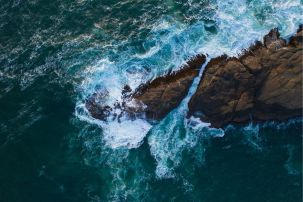Lesson summary
As a ‘thought starter’, students watch a short clip about a method of open-sea farming created by Sealeaf. To investigate the real-world application of this innovative farming method, students explore global mean sea levels from 1880 to 2013. Using a graph containing authentic data, your class will consider historic trends, calculate gradients of line segments, and comment on what the gradient represents. Finally, students will hypothesise who will be most affected by future sea level rise.
Learning intentions:
Students will...
- understand how to read data from a graph
- will calculate mid-point and gradient and comment on these in context
- discover the impact of sea level rising on a global scale.
Success criteria:
Students can...
- describe the key features of the graph.
- calculate mid-point and comment in context.
- calculate gradient and explain its context.
- conduct research for reliable sources of information.
Lesson guides and printables
Lesson details
Curriculum Mapping
Australian Curriculum content descriptions:
Year 9 Mathematics:
- Solve problems involving direct proportion. Explore the relationship between graphs and equations corresponding to simple rate problems (ACMNA208)
- Find the midpoint and gradient of a line segment (interval) on the Cartesian plane using a range of strategies, including graphing software (ACMNA294)
Syllabus outcomes: MA3‑2WM.
General capabilities: Numeracy, ICT Capability, Critical and Creative Thinking
Cross-curriculum priority: Sustainability OI.1
Relevant parts of year 9 achievement standards: Students make sense of the position of the mean and median in skewed, symmetric and bi-modal displays to describe and interpret data. Students find the distance between two points on the Cartesian plane and the gradient and midpoint of a line segment.
Time required: 60 min.
Level of teacher scaffolding: Low – teacher may need to demonstrate skills.
Resources required
- Student worksheet
- Internet access
Skills
This lesson is designed to build students’ competencies in the following skills:
- Communication
- Critical thinking
- Collaboration
- Digital literacy
Additional info
This is an original Cool.org lesson. Facts and figures in these lessons may have changed since this lesson was published. We always endeavour to update our resources in a timely manner, but if you see an error or issue in our resources please get in touch with us.


Welcome back!
Don't have an account yet?
Log in with:
By signing up to Cool.org you consent and agree to Cool's privacy policy to
store, manage and process your personal information. To read more, please see
our privacy policy here(Opens in new tab).
Create your free Cool.org account.
Many of our resources are free, with an option to upgrade to Cool+ for premium content.
Already have an account?
Sign up with:
By signing up to Cool.org you consent and agree to Cool's privacy policy to
store, manage and process your personal information. To read more, please see
our privacy policy here(Opens in new tab).